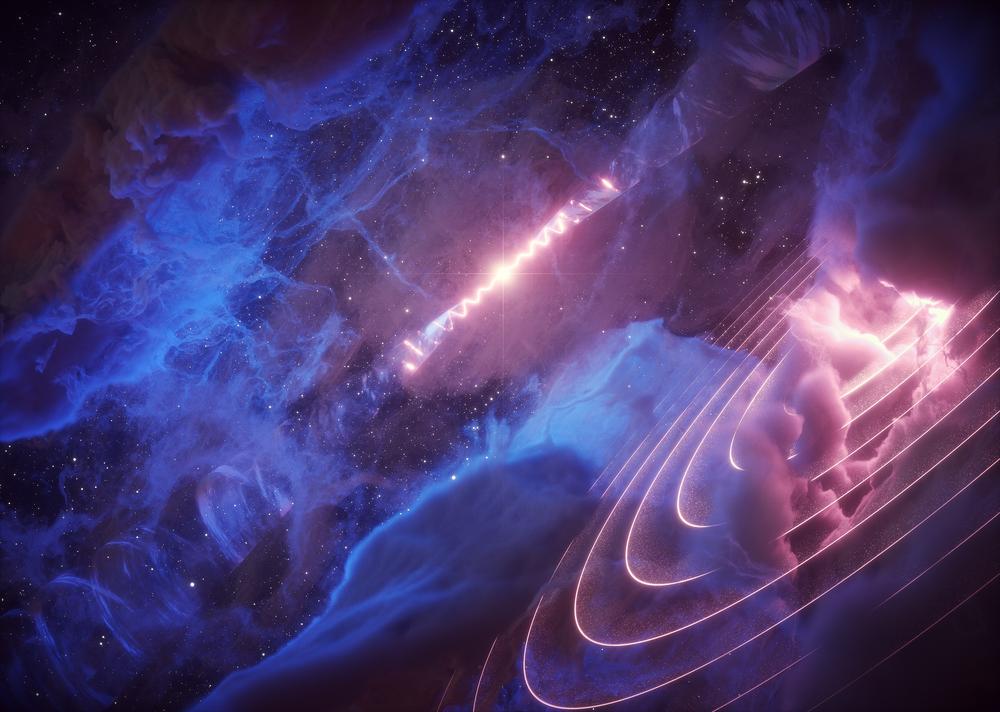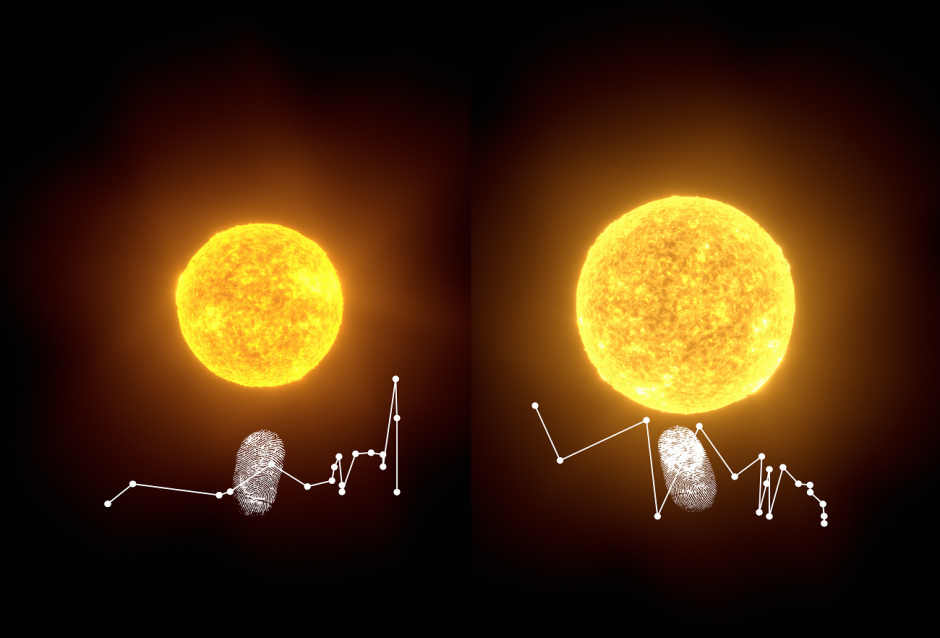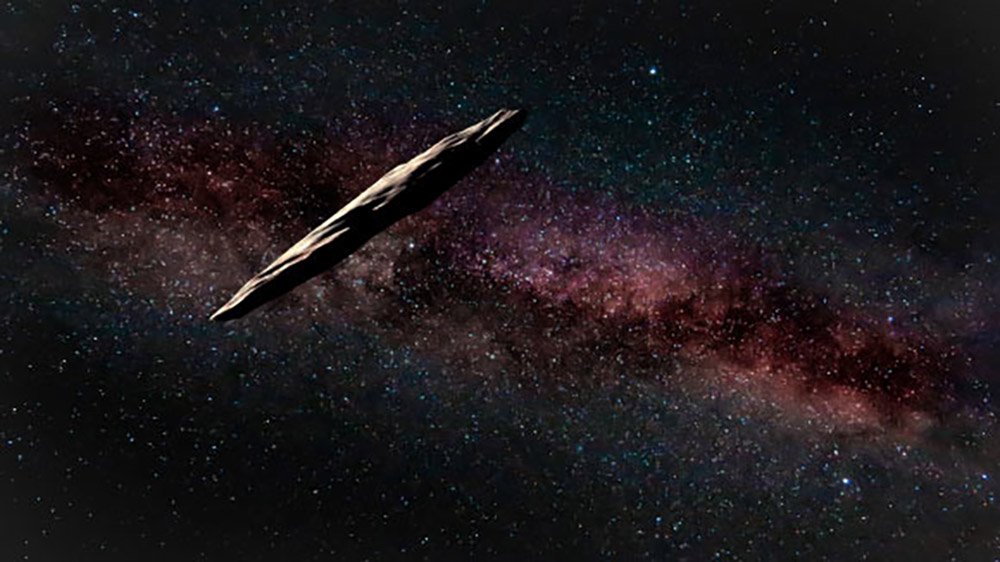Media
- Listen on Libsyn
- Watch on Twitch (WARNING: Audio inception fail at beginning.)
Transcript
Today’s news is entirely unsatisfying. In general, these stories create more questions than they answer. You are warned.
Story one: Two objects, 100 light-years apart, appear to be pulsing to the same rhythm, and it’s thought that they may be related, but it is all deeply confusing.

It all started with a black hole in a binary system with a massive star. The system is called SS 433. The black hole is gravitationally stripping material from its companion as they whirl around each other every thirteen days. That material spirals into the black hole, generating a disc that in turn drives a jet. Now, like an imperfectly spinning top, this entire spinning, orbiting mess is wobbling, with its wobble painting out a circle as it precesses. This precession causes the jets to appear as a spiral, since their origin point is going around and around, and using several years of Fermi data, a research team has figured out that precession takes 162 days. So far, so good. This is all fairly standard behavior for a microquasar.
When we widen our field of view, however, and look at the surrounding material, something weird can be seen. An otherwise average blob of gas, with the unassuming name Fermi J1913+0515, is giving off its own gamma-ray pulse every 162 days. This blob of gas isn’t aligned with where we currently see the jets pointing. The only thing tying these two systems together is their 162-day period.
According to led researcher Jian Li: Finding such an unambiguous connection via timing, about 100 light-years away from the microquasar, not even along the direction of the jets is as unexpected as amazing. But how the black hole can power the gas cloud’s heartbeat is unclear to us.
According to the paper on this system, which appears in Nature Astronomy, one possibility is that the accretion disc around the black hole is also precessing, and particles from the edge of this disc are illuminating the distant gas. A possible mechanism is the release of high-energy hydrogen protons that zip through space and collide with the gas to create the periodic gamma-ray pulse. If this is the case, this is the first time this kind of system has been discovered, and a lot of theoretical work is required to try and figure out what physics best matches this bizarre system.
I’m honestly not sure how I feel about high-energy particles from a black hole’s accretion disc being able to excite gas 100 light-years away into generating gamma-rays. What I do know is that it is an area of the galaxy we probably don’t want to visit.
Our second story of the day looks at the chemical composition of stars that are known to have planets. For a while, when we were starting to find extrasolar worlds, it looked like there might be a relationship between a star’s chemical composition and the fact that it had planets. Specifically, our Sun seems to have an atypical deficit of the kind of atoms that go into making planets. The general thinking was these materials ended up going into world-building during our solar system formation and thus are missing from the Sun. If this is how solar systems work, we’d expect to see this trend repeated with other stars that have planets. But, reality needs to be confirmed against expectation.

According to a new paper in the Monthly Notices of the Royal Astronomical Society (MNRAS), it turns out, reality does not match expectations.
A team led by Fan Liu measured the detailed composition of sixteen systems known to have planets and 68 reference stars not yet found to have planets and found that there was no notable difference between the stars with known planets and those not yet found to have planets. Moreover, the stars with planets had a wide range of characteristics showing planets really can form almost anywhere. I say almost, only because all attempts to find them around extremely metal-poor stars in globular clusters have so far failed.
So our Sun is back to being a deeply weird star chemically. One of our base assumptions in science is that we don’t live in a special place or a special time, but apparently our Sun doesn’t care about base assumptions and really wants to be unique.
At this point in our ability to detect extrasolar planets, we cannot detect all the kinds of worlds we see in our solar system around stars like our Sun. It may turn out that stars with as many rocky worlds as we have will generally have weird chemical ratios while those that have a world or two don’t require anything special. We don’t know. It’s annoying. I don’t like not knowing why our Sun is weird, and I look forward to someone figuring this out sooner than later.
In our final unsatisfying story of the day, we still don’t know what the interstellar object ‘Oumuamua is for certain, but we have one more piece of information about what it is not.

To catch you up on the story so far, back in October 2017, a strange object moving at a remarkable 196,000 mph was spotted zipping through our galaxy. While it originally was thought to be an interstellar asteroid, it’s motion was seen to change in ways that indicated something had to be outgassing, a behavior closer to what we expect from comets. This object didn’t have the carbon-based molecules we’re used to seeing from outgassing comets. This led to some people speculating it is an alien spaceship, others speculating that it is a hydrogen iceberg, and a lot of us admitting that the universe is far more creative in how it creates than we are in anticipating.
‘Oumuamua doesn’t have any of the infrared heat or energy signatures we’d expect from a spacecraft, so astronomers explored the possibility of it being a hydrogen iceberg.
I’m going to admit, prior to today, I had never heard of a hydrogen iceberg.
Apparently, some folks have theorized that deep in molecular clouds it is possible for hydrogen gas to freeze onto dust grains and build up over time to form large structures that could be the missing dark matter in our universe. If this is the case, these hydrogen icebergs should be scattered just about everywhere, and more should be plunging through our solar system for the future Rubin Observatory to observe.
A new paper by Thiem Hoang and Avi Loeb finds that the conditions in giant molecular clouds aren’t actually conducive to forming hydrogen icebergs, and if they could somehow form, then regular old starlight would be sufficient to eat away at any hydrogen icebergs that emerged from the dark depths of these clouds.
The idea of hydrogen icebergs is a bad idea, and we can all move on with the knowledge that they explain neither ‘Oumuamua nor dark matter. This means that we have no way to explain ‘Oumuamua.
I really hope we see a lot more ‘Oumuamua-like objects once the Rubin Observatory starts surveying the sky. This thing is weird, we don’t have enough data to sort it out, and this is exceedingly unsatisfying.
I think I’ve mentioned many times: scientists science so we can sort these kinds of unsatisfying things. When someone gets more data and a better handle on these systems, we’ll bring you the results, but for now, this has been the Daily Space.
Learn More
Cosmic Cloud’s Gamma-Ray Heartbeat Puzzles Scientists
- Deutsches Elektronen-Synchrotron (DESY) press release
- University of Central Florida press release
- “Gamma-Ray Heartbeat Powered by the Microquasar SS 433,” Jian Li et al., 2020 Aug. 17, Nature Astronomy
Stars with planets show no special fingerprint
- National Centre of Competence in Research PlanetS article
- “Detailed chemical compositions of planet-hosting stars – I. Exploration of possible planet signatures,” F Liu et al., 2020 July, Monthly Notices of the Royal Astronomical Society
‘Oumuamua Isn’t Made from Molecular Hydrogen Ice After All
- Center for Astrophysics | Harvard & Smithsonian press release
- “Destruction of Molecular Hydrogen Ice and Implications for 1I/2017 U1 (‘Oumuamua),” Thiem Hoang & Abraham Loeb, 2020 Aug. 17, Astrophysical Journal Letters (Preprint on arxiv.org)
Credits
Written by Pamela Gay
Hosted by Pamela Gay
Audio and Video Editing by Ally Pelphrey
Content Editing by Beth Johnson
Intro and Outro music by Kevin MacLeod, https://incompetech.com/music/


 We record most shows live, on Twitch. Follow us today to get alerts when we go live.
We record most shows live, on Twitch. Follow us today to get alerts when we go live.